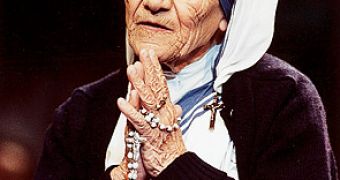This March, the journal Studies in Religion/Sciences religieuses is to witness the publication of a paper which stands to spark quite a lot of controversy, seeing how its topic is none other than Mother Teresa.
More so given the fact that this particular paper aims at proving that Mother Teresa's hollowed image has little to do with facts, and a lot to do with public and media relations.
Long story short: Serge Larivée, Genevieve Chenard and Carole Sénéchal are three researchers who have come to the conclusion that Mother Teresa was by no means a saint, and who now wish to introduce the general public to a more true to facts portrayal of this nun.
EurekAlert! informs us that these three researchers base their claims concerning Mother Teresa's not so holy nature on data collected while analyzing a total of 287 documents reporting on her life and work.
Thus, it appears that, despite her opening a whopping 517 missions spread across more than 100 countries, Mother Teresa actually did very little to help the poor and the sick, simply because she believed that people needed to suffer just as the Christ did on the cross.
According to Serge Larivée, Genevieve Chenard and Carole Sénéchal, Mother Teresa failed in providing the poor and the sick with proper care and sometimes even food.
Apparently, the nun used to defend her actions by saying that, “There is something beautiful in seeing the poor accept their lot, to suffer it like Christ's Passion. The world gains much from their suffering.”
Furthermore, this paper shows how, despite her receiving significant amounts of money from high officials and other influential individuals, Mother Teresa almost never used these funds in order to help those in need.
Quite the contrary: she settled for giving them medallions of the Virgin Mary and said that her prayers were with them.
The three specialists who pieced together this study into Mother Teresa's life argue that the church's decision to turn her into a saint mostly stemmed from their needing to increase their popularity.
“What could be better than beatification followed by canonization of this model to revitalize the Church and inspire the faithful especially at a time when churches are empty and the Roman authority is in decline?” they ask.
Just for the record, this paper is not the first to argue that Mother Teresa was not a saint, meaning that journalist and author Christopher Hitchens also took a great interest in this issue and even published a book intended to make the very same points.

 14 DAY TRIAL //
14 DAY TRIAL //